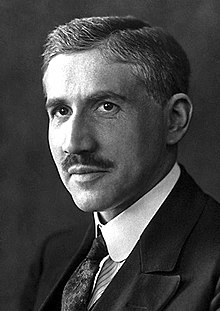Otto Fritz Meyerhof
Otto Fritz Meyerhof | |
|---|---|
 | |
| Born | 12 April 1884 |
| Died | 6 October 1951(aged 67) Philadelphia,Pennsylvania,United States |
| Nationality | German |
| Alma mater | University of Strasbourg University of Heidelberg University of Berlin |
| Known for | Relationship between the consumption of oxygen and themetabolismoflactic acidin the muscle |
| Awards | Nobel Prize in Physiology or Medicine,1922[1] Fellow of the Royal Society[2] |
| Scientific career | |
| Fields | PhysicsandBiochemistry |
| Institutions | University of Kiel |
Otto Fritz Meyerhof(German pronunciation:[ˈɔtoˈmaɪ̯ɐˌhoːf];12 April 1884 – 6 October 1951) was a Germanphysicianandbiochemistwho won the 1922Nobel Prize in Physiology and Medicine.[3][4]
Biography[edit]
Otto Fritz Meyerhof was born inHannover,at Theaterplatz 16A (now:Rathenaustrasse 16A),[5][6]the son of wealthyJewishparents. In 1888, his family moved toBerlin,where Otto spent most of his childhood, and where he started his study ofmedicine.He continued these studies inStrasbourgandHeidelberg,from which he graduated in 1909, with a work titled "Contributions to the Psychological Theory of Mental Illness".
In Heidelberg, he met Hedwig Schallenberg. They married in 1914 and had three children together: a daughter, Bettina, and two sons, Gottfried (who after emigration used the anglicized name Geoffrey) and Walter.
In 1912, Otto Meyerhof moved to theUniversity of Kiel,where he received a professorship in 1918. In 1922, he was awarded theNobel Prize in Medicine,withArchibald Vivian Hill,for his work on muscle metabolism, includingglycolysis.[7]In 1929, he became one of the directors of theKaiser Wilhelm Institute for Medical Researchin Heidelberg, a position he held until 1938, when Jews were expelled from university teaching positions.
To escape the increasing oppression of Jews by theNaziregime, in 1938 Meyerhof emigrated with his family to Paris.[8]After the fall of France in 1940, they fled to Marseille. Aided by theEmergency Rescue Committee,they left the country by ship to the United States that year. Meyerhof was appointed to a guest professorship at theUniversity of Pennsylvaniain Philadelphia.
Meyerhof died inPhiladelphiaat the age of 67.[9]In addition to receiving the Nobel Prize, he was recognized for his contributions to the study of glycolysis, by the naming of the common series of reactions for the pathway inEukaryotesas theEmbden–Meyerhof–Parnas Pathway.[10]
See also[edit]
References[edit]
- ^Raju, T. N. (1998)."The Nobel chronicles. 1922: Archibald Vivian Hill (1886-1977), Otto Fritz Meyerhof (1884-1951)".Lancet.352(9137): 1396.doi:10.1016/S0140-6736(05)60805-7.PMID9802314.S2CID54412926.
- ^Peters, R. A.(1954). "Otto Meyerhof. 1884-1951".Obituary Notices of Fellows of the Royal Society.9(1): 174–178.doi:10.1098/rsbm.1954.0013.JSTOR769206.S2CID161432856.
- ^Anon (1951). "Obituary: Otto Fritz Meyerhof".The Lancet.258(6687): 790–792.doi:10.1016/S0140-6736(51)91682-0.PMID14874513.
- ^"The Nobel Prize in Physiology or Medicine 1922".Nobel Prize.Retrieved11 January2011.
Otto Fritz Meyerhof was born on April 12, 1884, in Hannover. He was the son of Felix Meyerhof, a merchant of that city and his wife Bettina May. Soon after his birth his family moved to Berlin, where he went to the Wilhelms Gymnasium (classical secondary school). Leaving school at the age of 14, he was attacked, at the age of 16, by kidney trouble and had to spend a long time in bed. During this period of enforced inactivity he was much influenced by his mother's constant companionship. He read much, wrote poetry, and went through a period of much artistic and mental development. After he had matriculated, he studied medicine at Freiburg, Berlin, Strasbourg, and Heidelberg.
- ^Walter Selkeand Christian Heppner,The family of the Nobel Prize recipient Otto Meyerhof in Hannover,in: Hannoversche Geschichtsblaetter 71 (2017), p.156-166;ISBN978-3-86525-602-7
- ^"Uni Kiel – Otto Fritz Meyerhof".Uni-kiel.de.Retrieved26 June2017.
- ^Kresge, N.; Simoni, R. D.; Hill, R. L. (2005)."Otto Fritz Meyerhof and the elucidation of the glycolytic pathway".The Journal of Biological Chemistry.280(4): e3.doi:10.1016/S0021-9258(20)76366-0.PMID15665335.
- ^Jean-Marc Chouraqui, Gilles Dorival, Colette Zytnicki,Enjeux d'Histoire, Jeux de Mémoire: les Usages du Passé Juif,Maisonneuve & Larose, 2006, p. 548[1]
- ^"Dr. Meyerhof, Winner Of 1923 Nobel Prize".The New York Times.8 October 1951.Retrieved11 January2011.
Dr. Otto Meyerhof, co-winner of the 1923 Nobel Prize in Medicine, who had been a research professor in physiological chemistry at the University of Pennsylvania since coming to the United States from...
- ^Barnett JA (April 2003)."A history of research on yeasts 5: the fermentation pathway".Yeast.20(6): 509–43.doi:10.1002/yea.986.PMID12722184.S2CID26805351.
External links[edit]
- Meyerhof Curriculum Vitae and Obituary
- National Academy of Sciences Biographical Memoir
- Otto Meyerhofon Nobelprize.orgthe Nobel Lecture on 12 December 1923Energy Conversions in Muscle
- 1884 births
- 1951 deaths
- Nobel laureates in Physiology or Medicine
- German Nobel laureates
- German biochemists
- Jewish American scientists
- Jewish chemists
- Jewish physicians
- Jewish Nobel laureates
- American people of German-Jewish descent
- Physicians from Hanover
- People from the Province of Hanover
- Scientists from Berlin
- Scientists from the Province of Brandenburg
- Heidelberg University alumni
- University of Pennsylvania faculty
- Academic staff of the University of Kiel
- University of Strasbourg alumni
- Foreign Members of the Royal Society
- Jewish emigrants from Nazi Germany to the United States
- Members of the United States National Academy of Sciences
- 20th-century German physicians
- Max Planck Institute directors
